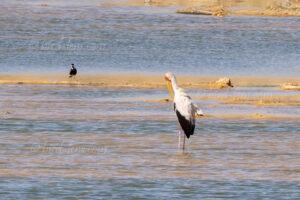 As if they had swallowed a stick, two individuals of a species known from Africa are standing on the banks of a chanal ot the Toshka Project. Between many Gray Herons (Ardea cinerea) two Yellow-billed Stork (Mycteria ibis) stand upright with hanging beaks. The colors are beautiful to see in the morning sun. I was looking for ornithological african influence to the western Palearctic. These birds complete the bird list for the western Palaearctic once again. Otherwise there are of course a number of Cattle Egrets (Bubulcus ibis) and Squacco Heron (Ardeola ralloides) roaming about. A surprise is the presence of a sizeable number of Northern Shovelers (Anas clypeata), which, as far as can be seen, are largely males.
As if they had swallowed a stick, two individuals of a species known from Africa are standing on the banks of a chanal ot the Toshka Project. Between many Gray Herons (Ardea cinerea) two Yellow-billed Stork (Mycteria ibis) stand upright with hanging beaks. The colors are beautiful to see in the morning sun. I was looking for ornithological african influence to the western Palearctic. These birds complete the bird list for the western Palaearctic once again. Otherwise there are of course a number of Cattle Egrets (Bubulcus ibis) and Squacco Heron (Ardeola ralloides) roaming about. A surprise is the presence of a sizeable number of Northern Shovelers (Anas clypeata), which, as far as can be seen, are largely males.
Shortly before we reach the intersection with a police check-point, the first bird experience can already be seen. Masses of Egyptian geese (Alopochen aegyptiacus) are to be seen in the sky. They come flying between the power lines of the high power pylons. A fantastic sight. An experience that is known from Central Europe from the migration of the Common Crane (Grus grus). Just now over the desert. They are flying in from the south and are undoubtedly heading for the waters of the (artificial) river. A little later we are back at the northern end of the bridge, at the place we had already visited two days ago. I let my driver drive down the dirt track all the way down again. There are some huts here. If you want, you can have tea with the Bedouins. I even find a shady spot at a hut. The spotting scope is set up quickly and I look through it.
The large-scale Toshka project, initiated in 1997, aims to make a dream come true. A dream that is supposed to solve many egyptian problems in one fell swoop: the desert is to be cleared and populated.
An incredible 25 million cubic meters of water are pumped out of Lake Nasser every day by the world’s largest pumping station and channeled into the 50-kilometer-long main canal. Despite the high outside temperatures, which can reach up to 50 degrees in the shade in summer, the precious liquid is led to Toshka openly and unprotected against evaporation. The amount of water is simply too high to be able to transport it in pipelines. For native birds, but especially migratory birds, it seems to be a boon. On a natural-looking canal running parallel to the concrete canal, the water level has dropped significantly compared to the winter flood. The side channel probably serves as an overflow to ensure an even flow of water in the concrete channel. Perfect conditions not only for the insatiable and the many herons.
The Yellow-billed Stork is widespread in the Afrotropics. In the western Palaearctic, it is only regularly detected at Abu Simbel in southern Egypt and at the Banc d’Arguin in Mauritania. In Egypt, the species is mostly observed in the summer months at Lake Nasser as a visitor in search of food. Perhaps the observations are mostly limited to the Abu Simbel region because this part of the area is visited somewhat more frequently by ornithologists due to the occurrence of afrotropical species and quite a good tourist infrastructure.
A 2020 study (Hering-et-al.-2020_Yellow-billed-Storks-at-lake-Nasser-Egypt.pdf) describes counts of the number of Yellow-billed Storks at Lake Nasser during three expeditions focused primarily on the breeding birds. Observations show that the Yellow-billed Stork occurs over large parts of Lake Nasser. Particularly notable were over 500 individuals recorded during an expedition in 2016. Peak numbers in Egypt are mostly observed from mid-June to mid-July. In so far, the observation of only 2 individuals end of April is only a taste, what is going to come.
On the other hand, unlike in the Abu Simbel region, there is some movement northwards along the coast of Mauritania in North West Africa during the rainy season (July-September).
To cope with the growing demand for top shots of the rarer species of the Palearctic Bird-Lens is keen to enrich the range of pictures of birds you can find in the western palearctic. Trips to remote places like this one to capture images not only of rare birds of western palearctic were very successful. The nice image of the blog is only a first impression, what you will find in the gallery in the “Picture Shop” very soon. Just give bird-lens.com a message, if bird-lens.com could serve you with an image needed before the new pictures are online.